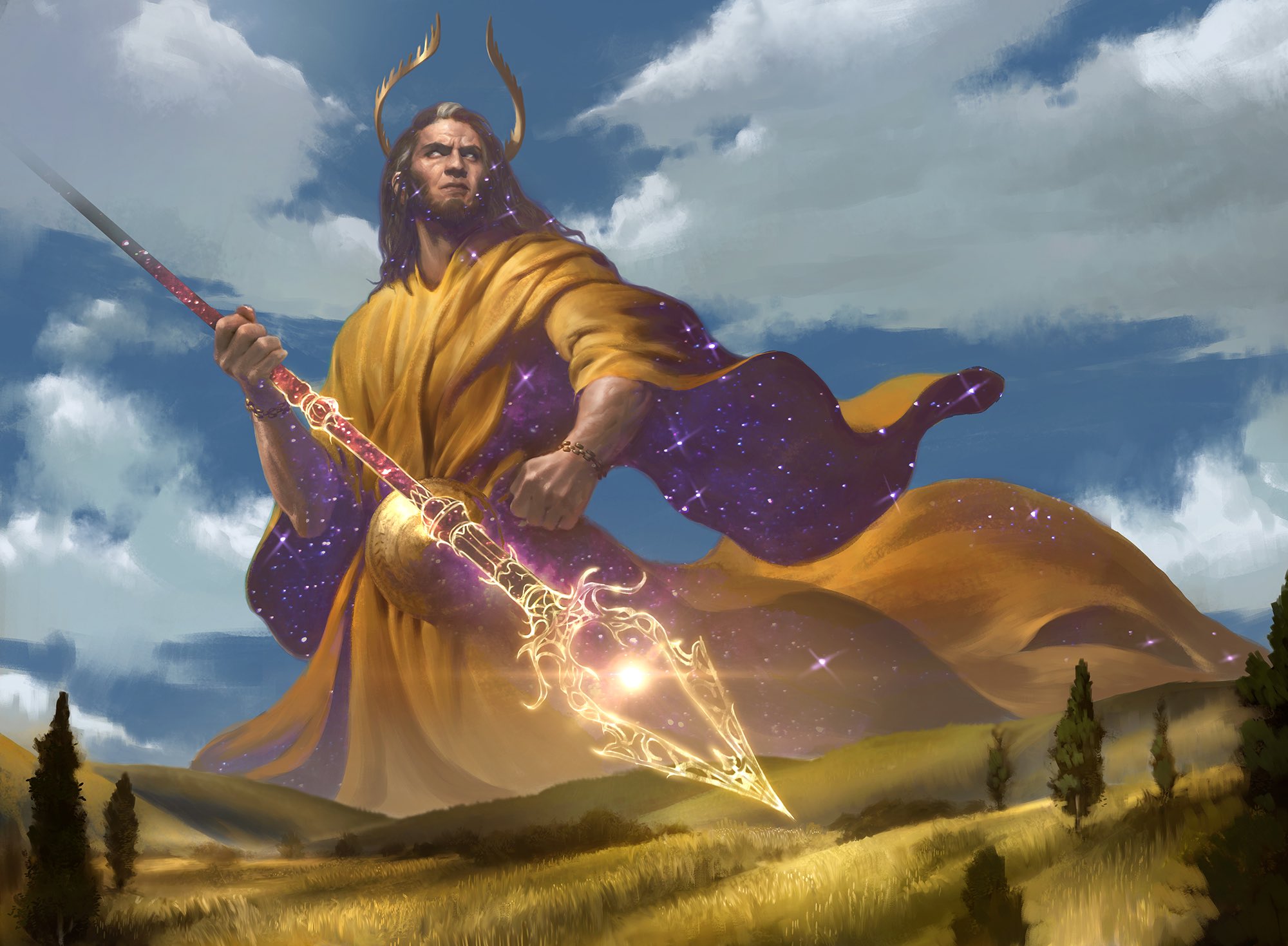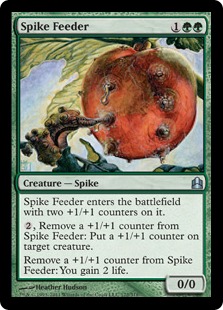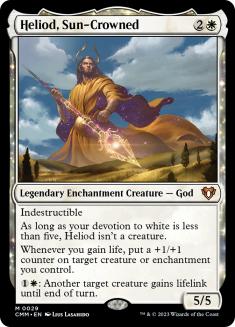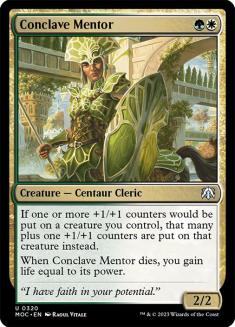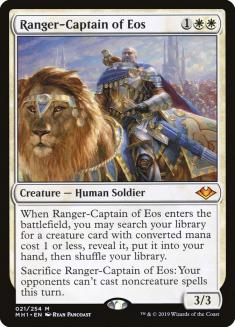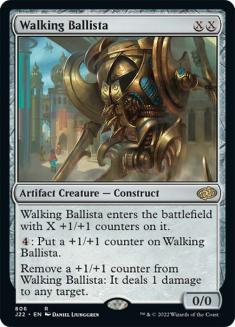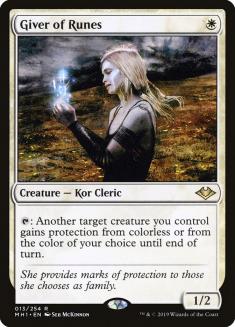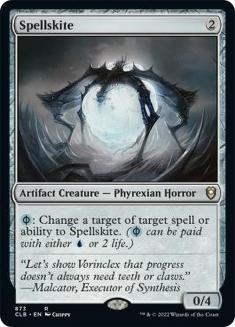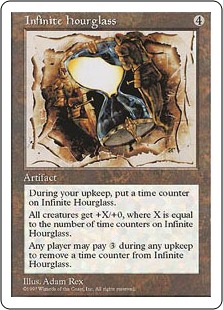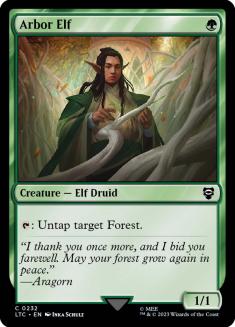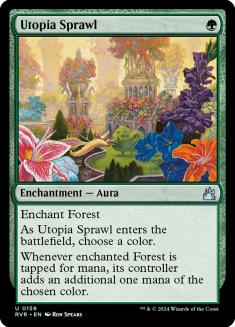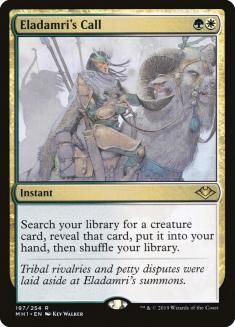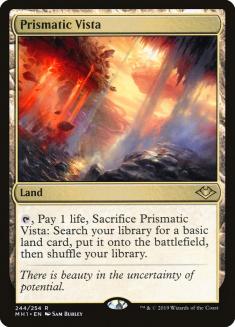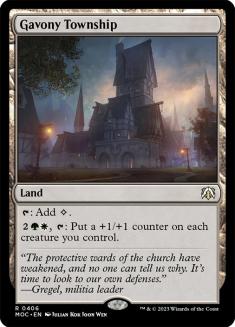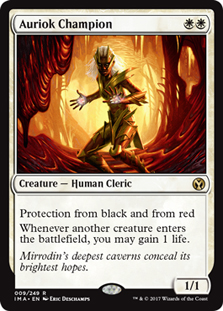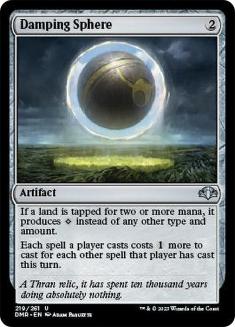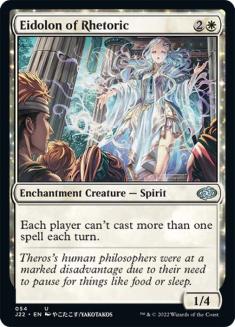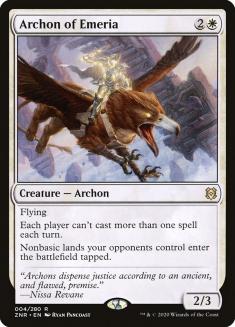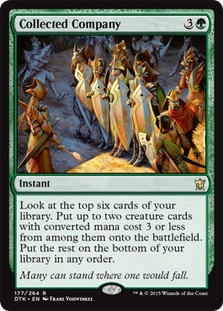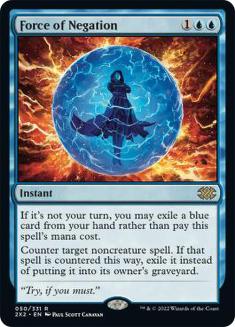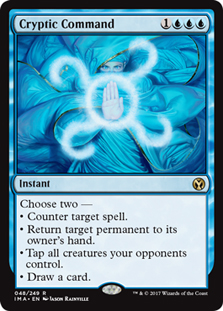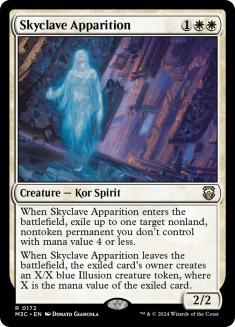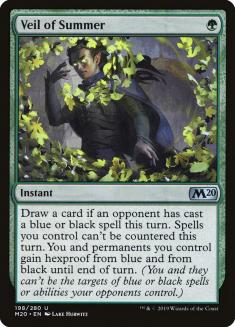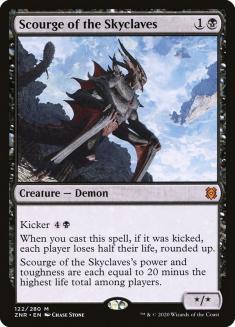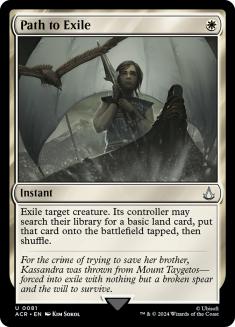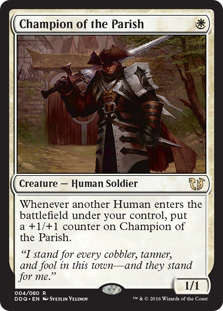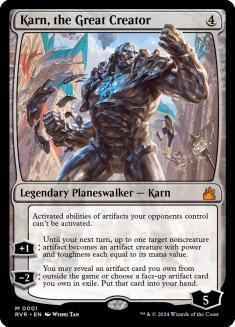Two weeks ago, I dove into Skyclave Apparition decks in Modern only to discover an unexpected candidate ending up well above the other options: Selesnya Company.
Since then I’ve had continued success with the deck, and importantly multiple other people have been able to replicate that. Notably, I’m not the only Star City Games writer who thinks the deck is great, with Ross Merriam astonishing everyone by recommending the deck over playing with broken cards like Omnath, Locus of Creation; Uro, Titan of Nature’s Wrath; and Mystic Sanctuary.
How is that even possible?
The Basics and the Next Steps
In case you missed it in all the other formats and nonsense of 2020, Heliod, Sun-Crowned plus Spike Feeder is an infinite combo. You remove a counter from Spike Feeder, gain two life, trigger Heliod to put a counter back on Spike Feeder, and you are back to the top of the loop with two more life.
Almost every game is going to be won by the core combo of the deck. Dealing non-infinite damage is a backup plan.
As weird as it looks to play Conclave Mentor in a deck with so few +1/+1 counter cards, it turns out to be a key combo piece. When you go off with the baseline Spike Feeder combo, it converts infinite life into infinite power. Each loop adds an extra counter to Spike Feeder, and then you can change targets for your Heliod triggers to turn that infinite power on Spike Feeder into infinite power on any creature you want.
The slightly higher-effort backup plan is also a Heliod combo, just the one more familiar to Pioneer players. The only difference if you don’t have to play a bunch of Walking Ballistas in Modern, just enough to find one with Ranger-Captain of Eos. The main reason this is the backup combo is how mana-intensive it is and how an exposed Walking Ballista is more vulnerable to removal in a Lightning Bolt format. Even if Ranger-Captain can buy a single turn of protection from removal, it’s mana-intensive to play Ballista and kill in the same turn…unless you have the previously mentioned surprise combo piece Conclave Mentor, which lets you pay two mana for a 2/2 Walking Ballista, for a total of four mana for the immediate kill.
The reason this combo has felt so successful in the current format is its shocking resiliency to spot removal. The problem with creature combo decks since Fatal Push was printed almost four years ago is that they have always provided your opponent a convenient window to cast a one-mana removal spell. All the Melira, Sylvok Outcast combos involved three pieces and deploying all that in a single turn is a chore. Devoted Druid plus Vizier of Remedies required untapping with Devoted Druid unless you had nonsense like Hall of the Bandit Lord or Postmortem Lunge.
This build of Selesnya Company doesn’t have that issue for a couple of reasons. Even if you need to cast multiple three-drops to combo, no one can kill a Heliod. It’s an indestructible enchantment; basically the only way to remove that is an opposing Skyclave Apparition. Seriously, I did a Gatherer search and beyond that it’s basically Deputy of Detention and Deicide.
And once you stick Heliod, you’re in a commanding position of threatening to combo on a dime. Your opponent needs to leave up mana to handle Spike Feeder in response to the activation and somehow every other card in your deck is a Spellskite that tanks a removal spell for the main combo.
Giver of Runes? That’s a Spellskite. Ranger-Captain of Eos? That’s a Spellskite. Collected Company? Usually hits something that’s a Spellskite. Conclave Mentor? Spike Feeder starts on three counters and can recombo in response to removal, that’s a Spellskite. Scavenging Ooze? Believe it or not, Spellskite. Activating in response to removal is another +1/+1 trigger to recombo with Spike Feeder.
If you want anecdotal evidence, I keep demolishing Jund because comboing through a removal spell is too easy. Fatal Push and Lightning Bolt used to be a death sentence for creature combo, and it just isn’t for Selesnya Company.
For those of you who are Magic Online players like me and worry about non-lethal infinite combos and the chess clock, the client supports this one fairly well. Just make sure to use the “… and save targets” and yield options right-clicking on the Heliod trigger, and it only takes a couple of minutes to gain a couple hundred life. Your opponent may be able to win with things like a Wrenn and Six emblem or Karn, the Great Creator in scenarios that wouldn’t work against paper definitions of infinite, but for most scenarios 200 or 300 life is enough time to find some way to go for actual lethal.
The last core of this deck is the Arbor Elf / Utopia Sprawl acceleration duo. While I mentioned the explosive aspect of this pairing in my previous Skyclave Apparition article, I didn’t emphasize how good Utopia Sprawl not dying to removal is. There used to be an extra potential choke point with these decks where interactive opponents could attack your Noble Hierarchs and get ahead to steal a game, and that just doesn’t happen with this deck.
Expect to see a lot more of this duo in Modern, and this is just one application of it.
The List and Microdecisions
I always strive to deliver credit where it is due, so thanks to Magic Online user coert for crushing it with the initial list that convinced me to try the deck and to Twitter user @matthewcapelou3 for pointing out the “this should have been obvious in retrospect” shift to Giver of Runes in the flex slots.
Creatures (28)
- 4 Spike Feeder
- 4 Arbor Elf
- 2 Scavenging Ooze
- 2 Walking Ballista
- 4 Giver of Runes
- 4 Ranger-Captain of Eos
- 4 Heliod, Sun-Crowned
- 4 Conclave Mentor
Lands (22)
Spells (10)

I still don’t love Eladamri’s Call, but it hasn’t been horrible. You need Heliod, Sun-Crowned to win most games and this is the best way to find it and you often have a natural gap in your curve on Turn 2, but it’s still really inefficient for 2020 Magic.
I’m unsure which secondary fetchland is the best. You do really want to find Temple Garden since you have 1WW and 1GG spells you need to cast on time, but not paying extra life to fetch a white source in a Scourge of the Skyclaves format is also great. Keep an eye on these slots until someone really figures it out.
Pendelhaven is a micro-advantage over a Forest, but it lets you pay less mana for some corner-case protected Walking Ballista kills. You can cast Walking Ballista for two mana as a 1/1, make it a 2/3 with Pendelhaven, and then pay two mana to give it lifelink to save a mana and pay a net five instead of the usual six.
Back to the restrictive costs, I’m unconvinced on Gavony Township in this deck. It’s really hard to have flexible 1GG and 1WW mana on Turn 3 with a colorless land in the mix. I loved Township in prior Selesnya creature combo decks that included Birds of Paradise in the Utopia Sprawl, but with fewer generic small creatures to load up with counters, Township falls a bit flat.
At the risk of preempting the sideboarding section, I’m unsure the sideboard has been optimized for this deck. At worst I know this list optimizes for high-impact cards, but I’m unsure these specific hate cards are necessary. Auriok Champion targets the Rakdos Death’s Shadow matchup that is already fine and starting to fall off in favor of Jund decks that exist to better combat Auriok Champion. Damping Sphere targets Mono-Green Tron, a deck perennial Tron lover Andrew Elenbogen has described as “ruinously bad” right now.
But the best decks in Modern right now aren’t especially vulnerable to specific hate cards, and these are certainly effective hate against the decks they target. It’s also worth noting the core of Selesnya Company is really broadly powerful, to the point that cutting cards is often a struggle because everything just works. Even if they aren’t the exact right sideboard cards for the metagame, they are at the least effective when you want them.
I do still prefer the one Eidolon of Rhetoric to the newcomer Archon of Emeria. Not dying to Lightning Bolt is still important in this format. Also, as I alluded to a bit earlier, this is just a cohesive deck relative to past Selesnya combo decks. You aren’t arbitrarily adding an Archon of Emeria to spike a nonbasic land lineup against a mostly normal deck. You want the most effective hate card for when you need to Eladamri’s Call for something, and Eidolon of Rhetoric plays that role the best.
Mulligan Strategy
I’m starting to think it’s malpractice to not lay out mulligan strategies in a London-era primer, so I’m setting a standard here.
I keep basically any hand with Heliod, at least two lands, and any other action. The card is the core of all of your combos. Once you have Heliod, you have twelve draws that immediately represent a combo: Eladamri’s Call, Ranger-Captain of Eos, Walking Ballista, and Spike Feeder. That doesn’t even count Collected Company, which is probably a win with eight hits.
Eladamri’s Call can be a stand-in for Heliod, but only on the play or if I have a solid ramp setup. Usually I think of it more as the secondary combo piece when keeping a hand; if I have Spike Feeder and Eladamri’s Call, that’s great.
Collected Company plus ramp is the other easy keep. Even if it doesn’t find Heliod, you can assemble something reasonable with it. I tend to keep non-ramping Collected Company hands if they have other setup pieces, like Conclave Mentor and a Ranger-Captain of Eos, and tend to mulligan if they aren’t generating other combo components.
Spike Feeder isn’t really a combo piece by itself, but I use it as an excuse to keep traditional lands-spell-curve hands. For example, if I have Conclave Mentor plus Spike Feeder with other action or ramp the play of “activate the two-mana ability of Spike Feeder to add a counter to itself and net power” might convince me to take a flyer on a hand otherwise missing a Heliod for a real combo.
Hands without either of the main combo pieces or Collected Company are the ones you need to take a critical look at.
A hand that threatens to cast Walking Ballista with a Conclave Mentor and significant other action is borderline. I tend to keep it if I have ramp, tend to really think it through if I don’t, and almost always ship if I’m on the draw.
Once you exclude those hands, you don’t have much action left in the deck. You’re talking about Giver of Runes protecting Scavenging Ooze and Conclave Mentor and should just try for something better. This isn’t the best London Mulligan deck since additional cards often directly translate to additional combo protection and you need a fair amount of lands and pieces to go off, but six card hands are usually a negligible downgrade from seven. Five cards is where the difference is noticeable, and even then I have won a fair amount from that spot. You just aren’t quite on the Mono-Green Tron level where five versus seven cards is a matter of semantics.
The Matchups
VS Uro/Omnath Piles
Given infinite time, most Uro lists in Modern can beat infinite life, especially Magic Online infinite life. Jace, the Mind Sculptor’s ultimate is the main reason for this, but in paper play most lists could get a Teferi, Hero of Dominaria or Wrenn and Six emblem, kill everything, and eventually use Cryptic Command plus Mystic Sanctuary (not choosing to draw a card each cast) or just Nexus of Fate to never deck.
This typically means that the lethal versions of your combo with Walking Ballista or Conclave Mentor are a true step above just Spike Feeder and Heliod. In an odd reversal of digital platform woes, the Uro list worst at this is Four-Color Copy Cat, since their infinite combo takes at least twice as much time to execute to deal lethal through your “Magic Online infinite” life total.
Note that both Teferi, Time Raveler and Teferi, Hero of Dominaria represent ways to temporarily clear Heliod. Resolving it usually your best play, but it isn’t quite the assured slam it is against other decks.
Casting Collected Company on your opponent’s turn is big. Make them pay mana to answer it.
Ranger-Captain of Eos is at its absolute best here and is a big part of your all-three-drop deck’s plan against Cryptic Command. Think through what happens if they bounce something in response to the sacrifice, but otherwise the card keeps you nice and safe from interaction.
Out (VS Four-Color Copy Cat):
In (VS Four-Color Copy Cat):
The Felidar Guardian lists are light on blue interaction you need to worry about and heavy on permanents you would like to clear out. The also lack Mystic Sanctuary and are short on Uro, so Scavenging Ooze is less relevant. A Path to Exile might be better than another Giver of Runes, but I don’t want to get too interaction-heavy and risk low-impact draws.
Out (VS most other lists):
In (VS most other lists):
The other Uro lists have blue interaction and sometimes even black interaction. You have a card for that job. I’m unsure of the exact mix of the three cards coming count I would cut, but I wouldn’t touch the combo pieces.
VS Lurrus/Thoughtseize Decks
This has generally been a great matchup for Selesnya Company for all the reasons I talked about earlier. You’re so good at threatening a combo through interaction and have cards that play great in resource grinds. Infinite life or online infinite life is usually enough to lock up a win.
Arbor Elf tends to be a liability here, especially against Rakdos lists. It’s not action and it’s an easy interaction point if you stumble, giving them a way to removal spell their way to victory.
Scourge of the Skyclaves has been the universal adoption of these decks, whether they’re Jund or Rakdos. That’s great news, because the card is stupid in this matchup. Not only does Spike Feeder just exist, but in corner cases where you get ground out, you just give Scourge lifelink with Heliod to prevent it from dealing good damage over multiple turns. Just be aware that you want to Turn 1 fetch Temple Garden a bit less than normal in this matchup.
Out (VS Jund):
In (VS Jund):
You want the last Veil of Summer over some less impactful creature if you see extra black removal like Abrupt Decay, but I have been burned by playing against lists that are basically Rakdos but splashing Tarmogoyf. Keep an eye on the cards they play and see if anything weird is going on.
Eladamri’s Call isn’t a dead card in the matchup, but you tend to win more when you keep making plays that force them to do something and less when you burn a turn setting up. You are also bringing in a lot of non-hits for Collected Company and would like to not miss on that card.
Out (VS Rakdos):
In (VS Rakdos):
Auriok Champion says “protection from black and red.” Your opponent has only black cards and red cards. High-skill maneuvers.
VS Humans
Gotta go fast, and infinite life should do it. The only non-combo hands worth considering involve fast, large Walking Ballistas on the play off something like Utopia Sprawl and Conclave Mentor. There isn’t a ton of nuance here besides thinking about Skyclave Apparition or Magus of the Moon after sideboarding.
Out:
In:
I treat most of the dedicated Skyclave Apparition decks in a similar way to Humans, with the one caveat that I tend to expose my non-Heliod combo pieces before Heliod due to Skyclave Apparition. You have fewer copies of Heliod, so losing it to exile is a bigger issue. Against Humans I only switch that ordering after sideboarding since Reflector Mage on Spike Feeder is much more of a Game 1 issue.
VS Big Mana
Another low-nuance, fast-combo matchup. Also another matchup where lethal combos are notably better than non-lethal. Even against Eldrazi Tron, I assume my opponent has some Karn, the Great Creator option that lets them beat even paper infinite life.
Out (VS Amulet Titan):
In (VS Amulet Titan):
Against the Elvish Reclaimer / Primeval Titan lists that have popped up without Amulet of Vigor and Simic Growth Chamber, your sideboarding is identical minus the Damping Spheres. Skyclave Apparition managing either a one-drop or Dryad of the Ilysian Grove is huge, and when the list used to have a Knight of Autumn I wanted that card as well. A silver-bullet creature here wouldn’t be the worst, and a sideboard plan I would entertain if this deck gets big again is a Stomping Ground and Magus of the Moon.
Out (VS Mono-Green Tron):
In (VS Mono-Green Tron):
I don’t love Skyclave Apparition here, especially on the draw when you can’t even Turn 2 it and mise an Expedition Map, but it does something.
Against Eldrazi Tron I’m fine with some Giver of Runes to just let my random creatures block repeatedly. I bring in Path to Exile and don’t bother with Damping Sphere because half the time they just spend Tron mana on Matter Reshaper.
The Real Deal
This set of matchups might be the perfect showcase of how good Selesnya Company is right now. You certainly aren’t actively trying to beat them. Your sideboard options are currently somewhere between fine and suboptimal.
But the consistency and speed of the core combo here often lets you just win anyway. If there’s a better sign of a good Modern deck, I don’t know what it would be.

